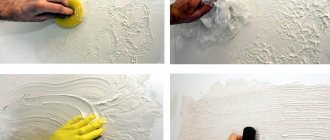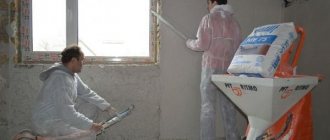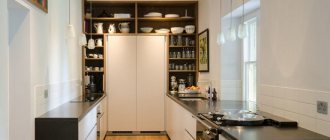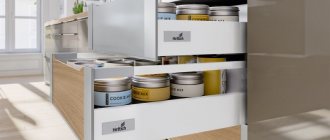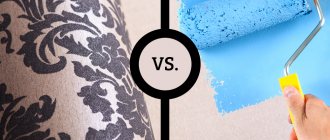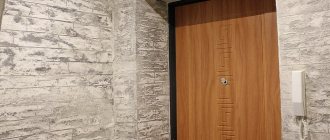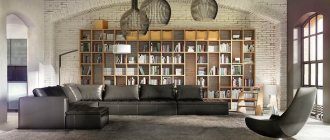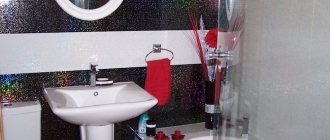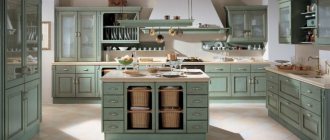Decorative plaster for the kitchen, which one to choose. What material to choose for wall decoration?
When choosing decorative finishes, special attention is paid to the following parameters:
- value for money;
- complexity of application and level of final result;
- resistance to cracking;
- the beauty of the resulting coating.
Be sure to pay attention to the type of binder. The reliability of the finishing layer, adhesion to the surface being treated, and durability depend on the base.
Below are the criteria for choosing the best decorative plaster for finishing various objects.
For the corridor
The hallway is a narrow room with little lighting. The walls become dirty more often and cracks form due to high humidity and drafts. The finishing should not only please the eye of the owner of the room, but also be practical to use.
When purchasing a mixture, it is recommended to focus on the following criteria:
- high moisture resistance so that dirt can be easily washed off with water;
- strength - the resistance of the finish to various mechanical influences will depend on its level;
- plasticity and resistance to deformation;
- requirement for the quality of the base.
Additionally, take into account the features of finishing the corridor:
- Often there is no natural light in the room, so it is better to decorate the walls in lighter colors. If you use dark colors, you should arrange the maximum amount of artificial light.
- Decorate a small hallway with materials that ultimately provide a smooth surface.
- Pay attention to the general condition of the walls. If there are small cracks, use a coarser plaster.
- If the walls are perfectly flat and smooth, then Venetian plaster will be an excellent choice. It is applied in a thin layer and completes the overall interior of the corridor.
- Treat surfaces with defects with textured or structural plaster. The composition is distributed in a thick layer, often more than one.
We invite you to look at photos of corridor design options:
For facade
When purchasing a decorative facade covering, it is important to be guided by the following parameters:
- Characteristics . High indicators of strength, moisture resistance, service life, expediency of application. For example, areas with increased contamination require the use of a dirt-repellent mixture. There is no need to select difficult-to-maintain plaster, but at the same time it must have good vapor permeability.
- Facade material. Cement-based decorative plaster is suitable for any type of wall. Silicone material is not recommended for use on external insulation. Silicate is perfect for walls made of aerated concrete or gas silicate. Brick and block surfaces are not picky about the type of plaster applied.
Attention
If the facade of the house is made of wood, then it is necessary to create two layers. The first is a cement base, the second is a decorative coating. Additionally, the mixtures must have good vapor permeability. Otherwise, moisture will accumulate between the insulation and the finishing coating, which will lead to damage to this finishing of the house.
Below are options for decorating the facade with decorative plaster:
For kitchen
The kitchen is a high-traffic area that often gets dirty. Therefore, decorative plaster should be easy to wash and not be afraid of mechanical stress and the accumulation of fat. Good options are acrylic and silicone compounds. They have the following advantages:
- resistance to high humidity, sudden changes in temperature (in the kitchen the temperature changes very often as stoves and heating equipment are turned on);
- plasticity - cracks do not form;
- easy to use - can be sold ready-made;
- attractiveness - the final result will please even the most demanding owner.
Advice
Many designers use silicate plaster, which is based on liquid glass. After treatment, the wall acquires a light glossy shine and luxurious beauty. But this is an expensive material that easily deteriorates from exposure to hot steam. Therefore, you should not overpay, but consider other options.
Options for applying decorative coating to the wall
Usually decorative plaster is sold in a finished state. This composition can be applied to leveled walls, after plastering and puttying the walls, as well as on surfaces made of plasterboard or plywood.
Finishing walls with an even layer
This method is completely identical to the puttying technique. The finished mixture is applied to the prepared surface using a wide spatula in any direction. The thickness of the layer is no more than two millimeters, which dries completely after 18 hours.
Washable plaster for the kitchen. Types of materials
Decorative plaster is not exactly the usual plaster or mortar used for leveling walls.
This is a finishing material, a special homogeneous paste, a mixture for finishing and decorating walls, ceilings, and structures. It consists of tiny grains of granite, marble or quartz chips, sand, and even pieces of algae.
Construction stores have a large selection of decorative plasters, both natural and artificial materials.
- Mineral. A dry mixture based on cement-lime mortar, marble or granite chips are added to it for relief and elasticity. This composition is durable and resistant to dampness and moisture.
- In synthetic plasters, the binding agents are polymeric materials, for example, acrylic resins, styrene, nylon fibers, liquid glass, etc. These mixtures are sold in ready-to-use formulations.
Silicone plaster (based on synthetic resin) is easy to apply, very plastic, adheres well, and is suitable for finishing external and internal surfaces.
Acrylic is easy to work with, adapts to any tool, dries quickly, is elastic and wear-resistant. Silicate is based on liquid glass, which is characterized by vapor permeability and resistance to mechanical damage. This plaster is also called universal.
Experienced craftsmen recommend choosing acrylic-based plaster for the kitchen area.
This wall covering is very practical: it is resistant to grease, is not afraid of water, does not absorb kitchen odors, and is easy to care for; you just need to wipe the wall with a damp cloth.
Advantages and disadvantages
When using a type of finish, it is recommended to consider the pros and cons.
Putty has the following advantages:
- wide palette of shades and textures of materials;
- the ability to reproduce natural materials;
- correction of unevenness on walls;
- resistance to humidity, temperature changes;
- durability (shelf life up to 20 years);
- resistance to mechanical damage and chemicals;
- fire safety;
- environmental friendliness of the composition;
- seamless application, no joints;
- versatility in application;
- easy care of the coating;
- ease of application;
- availability of different application techniques and design options;
- the opportunity to create an original room design.
The list of material shortcomings:
- high price of plaster with natural stone chips and other original components;
- inelasticity of the coating, the possibility of cracks;
- It takes more time than standard to decorate with Venetian plaster;
- difficult dismantling;
- water permeability of some types of material.
What is better for the kitchen: wallpaper or decorative plaster. Criteria for choosing a wall finishing method
Decorative plaster or paintable wallpaper - which is better? When answering this difficult question, you need to understand by what criteria a preliminary assessment of a particular material is carried out. The main criteria are:
- Durability of the selected coating.
- Price.
- Ease of use.
In terms of durability, wallpaper is inferior to the mixture. The prospect of re-pasting failed wallpaper is more likely than re-treating the walls with a competing composition.
Considering the pricing policy of the two materials, one must agree that wallpapers are much cheaper, although when choosing them you can encounter a high price.
For example, photo wallpaper, fabric or paintable wallpaper. The minimum price of plaster starts from 200 rubles. And the lowest cost of wallpaper does not exceed 50 rubles.
When performing repairs yourself, ease of use plays an important role. After all, it is easier to cover walls with wallpaper than to plaster the walls.
Durability
Any person carrying out repairs wants to receive a high-quality product that will be pleasing to the eye and will last a long time. For example, rare wallpaper will last about 5 years. Non-woven wallpaper will retain its beauty for 10 years. And only fiberglass materials can be used for up to 20 years. The service life of decorative mixtures is much longer than any wallpaper.
The silicone finish will provide 60 years of flawless service. Polymer will last 50 years, and mineral up to 30 years. Any decorative plaster can be washed and simply restore cracked areas.
Appearance
Expensive decorative plaster competes with other finishing materials. Experts disagree on which looks better. Rather, the choice depends on a person’s taste, the cost of the material, its qualities and service life.
Resistance to external influences
Of course, there are wallpapers that can be used in rooms with high humidity, but they need to be changed periodically. This despite the fact that the walls are pre-treated with a special compound to prevent mold.
Using decorative plaster in work areas: kitchen or bathroom, you can be sure that a high-quality finish will last up to 60 years. The appearance of mold and rotting processes is excluded.
Price
Wallpaper takes the lead in terms of affordability. The cost of plaster is several times higher than that of competing materials. Treating 1 m2 of wall with wallpaper is cheaper than working on the same area with decorative mixtures. Take, for example, treating walls with Venetian plaster. But the question of whether decorative plaster or wallpaper is cheaper should not be guided solely by price. Much depends on the service life of the material and its properties.
Decorative plaster in the kitchen: pros and cons. pros
Today, finishing kitchen walls with decorative plaster is becoming increasingly popular. There are many explanations for this; this coating has a number of advantages that have attracted attention to it for many years. The undoubted advantages of using decorative plaster include:
Decorative plaster in the kitchen
- Durability - plaster will serve well for decades. However, it is worth mentioning that such a long service life can only be achieved if the technology is fully followed and high-quality materials are used. If these conditions are met, there is no doubt that the coating will remain in excellent shape for a long time.
- Many design options - indeed, decorative plaster coating can be made in a variety of variations! And if you wish, you can create your own ornament, this will make the kitchen truly unique. The same applies to color - you can choose it from the entire color palette, based solely on your own wishes.
- The absence of seams and joints is a strong argument in favor of plaster. Surely, when gluing wallpaper, many have suffered more than once, getting rid of noticeable joints and gaps. With decorative plaster this problem will not arise - the coating will be solid and even.
- The cost is quite low, although it is worth noting that there are types that require significant costs.
- Hiding defects - if the rough wall doesn’t look very noble, don’t worry, finishing the kitchen with decorative plaster will hide everything!
- Environmental friendliness - plaster coating is considered quite environmentally friendly. Walls with this finish “breathe”, unlike walls finished with plastic.
Decorative plaster for kitchen finishing: features of choice and price
Today, more and more often, designers are turning to decorative plaster to decorate the kitchen. Wallpaper and tiles have become common interior design solutions. Plaster is a fairly durable and visually attractive material, which is why its popularity is growing rapidly.
Decorative plaster is a homogeneous mass into which admixtures of marble chips, granite and other elements can be added to make the structure of the material interesting. Plaster can be of different types; it can be used to hide some surface defects. The color scheme of this coating is very diverse. Decorative plaster allows you to imitate stone, marble, metal, and can be used to apply any texture to the wall. In addition, it is suitable for decorating not only walls, but also doorways, arches or ceilings.
Features of decorative plaster
This finishing material has a long list of positive qualities:
- Decorative plaster is a universal coating, and it is applied quite simply.
- A brick, concrete, wood or metal surface that has been previously prepared is suitable for this coating. If you follow the recipe and rules for preparing the mixture, even a beginner can handle the job. True, there are certain types of plaster, the application of which will require serious skills and experience of the master.
- Decorative plaster has no seams. In addition, it masks some surface defects.
- This material has hydro-, heat-, and sound-insulating properties. This feature of the material is perfect for the kitchen. Decorative plaster does not absorb odors and is easy to clean because it repels water.
- Decorative plaster is a safe coating from a toxic point of view. It is environmentally friendly and consists of natural materials. She is not afraid of temperature changes, as she can withstand temperatures from -50 to +70 degrees. Plaster is resistant to the formation of fungus and is a non-combustible material.
- The appearance of decorative plaster is truly beautiful. Its surface can imitate stone, leather, wood, paper, metal. This variety of possibilities allows you to create unique kitchen interiors. Not every finishing material can provide the same choice of finishing options, and there is no need to limit yourself to the color scheme.
- Plaster is durable. If you prepare and prime the surface efficiently, follow the application technology, and also operate and care for the coating according to the instructions, then it will delight you for a long time. The service life of decorative plaster can last more than 10 years.
Along with the advantages of decorative plaster as a covering for the walls or ceiling of a kitchen, it has its own disadvantages:
- Depending on the type of decorative plaster, the surface on which it will be applied, and the complexity of the finishing, it may be necessary to contact a specialist. Not all types of work can be done independently.
- The interior of the kitchen will look expensive and luxurious, but such finishing can cost a lot of money.
- For 1 sq. per meter of surface, quite a lot of material is consumed.
- Sometimes dismantling an old decorative plaster coating can be a real problem.
Working with decorative plaster
The application of this material has its own characteristics. Decorative plaster is usually not painted, because the material with the addition of dye or inclusions is immediately used. If you plan to paint, then use colorless but textured plaster.
The classic use of decorative plaster has become the imitation of stone surfaces, but the possibilities of this material are much wider. There are stencils, special rollers and other tools that allow you to create the texture of leather, textiles, metal, paper or wood. You can make stains, applications and panels on the walls and ceiling.
Experienced craftsmen create washes of several tones of the same color to create interesting surfaces. It looks very impressive.
What types of decorative plaster are there?
- Textured plaster - using various application techniques you can achieve different surface options.
- Structural plaster - its composition includes inclusions of different sizes. Typically they range from 0.7 to 3 mm. Using different application methods, you can create different patterns on the surface.
- Mineral plaster - marble or granite chips are added to it; this type of plaster is highly resistant to moisture.
- Venetian plaster . They say that the very idea of creating this coating appeared in Ancient Rome. Then it was decided to use marble dust and chips to decorate the walls of the premises. Then the inhabitants of Venice adopted this technique, and this is how the name appeared. Today, traditions and technologies have received new developments. Venetian plaster now pleases the eye in modern interiors.
- Smooth plaster . This type of finish is ideal for a minimalist kitchen. The plaster is applied in several layers, and the surfaces are smooth.
- Relief plaster is plastic and can imitate natural materials. It is the easiest way to hide imperfections in walls or ceilings.
Decorative plaster is also classified depending on the binder.
If you follow this principle, then plaster can be:
- Silicate.
- Mineral.
- Acrylic.
- Silicone.
Acrylic plaster is based on acrylic resin and is sold in finished form. But mineral is a dry mixture based on cement. To prepare it for work, you still need to add certain ingredients that will make it textured and flexible. Both types of plaster combine well with mineral bases.
Silicone plaster based on synthetic resin and has high ductility. This feature makes application to the surface simple. The plaster easily adheres to the base. It is well suited for indoor and outdoor work. In this case, the surface does not have to be mineral.
Silicate plaster is based on special liquid glass. The most important advantage of this type of material over others is good vapor permeability. It is also resistant to external influences. Plus its consistency is already ready for use. Because of all its qualities, it is called universal, which could not but affect the price of this material.
It is impossible to say for sure which plaster is better or worse. In each specific case, you need to make a separate choice. It depends on the wall material, the effect to be achieved and many other factors.
If you try to choose the best plaster manufacturer, you won’t be able to find very big differences. Basically the benefits are the same for everyone. It’s just that each manufacturer has its own innovations, unique additives or color palette. A good sales consultant will simply be able to explain which type of plaster is more suitable in a particular case. If you have several options to choose from, then it is better to be guided by comparing price, quality and personal preferences. Today, the best recommendations come from plastering manufacturers from Germany and Italy.
Using decorative plaster in the kitchen
Which of the options for using decorative plaster in the kitchen are most appropriate? Naturally, these are walls, openings, arches, niches, ledges and ceilings. You can combine textures, colors, and coating patterns, achieving very impressive results.
There are no restrictions on the use of decorative plaster on walls, but in the work area it is better to avoid using it, especially if the structure of the plaster is porous. In this case, it will absorb dirt and moisture. It is better to decorate the apron with tiles in the food preparation area or cover the plaster with transparent plexiglass. But for the dining area, decorative plaster is perfect.
You can divide the kitchen into zones using decorative plaster of different colors, textures, patterns or application techniques.
If you don’t want to make a regular plain ceiling, then you can apply decorative plaster to it. It may be difficult to do this on your own, but you will get a very impressive interior. You can make a pattern that imitates clouds, the sky, or apply patterns using templates or stencils.
Decorative plaster comes to the rescue when it is necessary to hide ventilation ducts, various pipes or meters leading outside. They can be decorated with protrusions, columns or arches. Door and window openings should also be finished with decorative plaster; the overall interior of the kitchen will look expensive.
Surfaces with the effects of cracks and craquelure look very interesting. This is achieved using a special varnish. Such a surface is well suited for an old-style kitchen; in addition, in this way all the imperfections of the surfaces will be hidden.
In general, decorative plaster in the kitchen has a number of advantages over other materials for finishing work. It will decorate the interior of the kitchen; it can be used to imitate various surfaces.
Approximate prices for decorative plaster
The total cost of decorative plaster will depend on its consumption per 1 square meter. meter. Accordingly, the thicker the layer, the higher the consumption will be.
Today, Venetian plaster can be purchased at a price of 2,400 rubles per 5 kg package. The price may increase depending on the finish you want to use. For example, it could be varnish or paint. You also need to take into account the preparatory work.
If we conduct a comparative analysis of material costs per 1 sq. meter, then for smooth plasters this figure will be around 465 rubles, for Venetian plaster – 128 rubles. The cost of applying textured plaster will be from 300 rubles per sq. m. meter. It is better not to consider flock options for the kitchen, due to the peculiarities of caring for them. If a final wax coating of plaster is required, the price will rise by 80-100 rubles per sq. m. meter.
The cost of work also depends on many factors, and the price can sometimes be higher than the cost of materials. The minimum price that a finisher will charge is 300 rubles per sq. m. meter, but you can’t count on this figure. In fact, it all depends on the type of material and the surface you have to work with. Complex curves, openings, arches and niches will cost more, as will work with the ceiling. In addition, creating some textures is a rather painstaking task. A good finisher with experience will agree to work with Venetian plaster or flock covering for no less than 700 rubles. Therefore, calculate in advance; perhaps you should give preference to those types of plaster that are not fussy to apply and that you can handle yourself. Then luxury turnkey apartment renovation will not become a heavy financial burden.
Silk plaster in the kitchen. Types of decorative plaster for the kitchen
To understand which decorative plaster to choose for the kitchen, let’s study the composition of various types of coating:
- Natural marble or granite chips and quartz sand are added to cement-based mineral plaster, thereby creating a relief surface. Gypsum-based coating is not suitable for the kitchen. Gypsum absorbs water, swells and loses its properties.
- Acrylic contains acrylic resins at its base. This is a good choice for the kitchen. It will create a durable and strong wall covering.
- Silicate plaster with a liquid glass base is recommended for use on walls made of wood or cellular concrete due to its vapor permeability.
- Silicone plaster is plastic and suitable for application by hand. Has good adhesion to many substrates.
In appearance, plaster can be:
- Structural - depending on the size of the fractions included in it, it is divided into coarse-grained and fine-grained; When applied, large grains in the plaster form deep grooves, resulting in a “bark beetle” pattern. Bark beetle plaster in the kitchen goes well with furniture in the Provence style.
- Venetian contains marble dust and creates a smooth surface reminiscent of marble. Venetian, as one of the most expensive and beautiful coatings, belongs to the category of elite finishing and is used to create palace interiors in the baroque and classicism styles.
- Textured imitates various materials: wood, leather, concrete, crinkled fabric, etc.
- The smooth coating is suitable for different interiors. Bright kitchen furniture and textiles will balance the smooth walls in a calm color scheme. A minimalist interior with high-tech furniture will be complemented by richly colored walls.
In the bathroom and toilet
For the bathroom, you can use bright Venetian finishes, which, combined with good lighting, will transform a small room into a unique corner of the apartment. Smooth plaster in the bathtub and toilet goes well with the tiles. You can lay the floor and part of the wall with tiles, and then plaster over it with “Venetian” plaster. The ceiling is also often decorated with plaster.
Thanks to the wax layer, the surface of the walls will be moisture resistant. It is worth remembering that walls in damp rooms are prepared for plastering in a special way - they are primed several times with a hydrophobic primer. It is advisable not to use gypsum mixtures for finishing, because... they require good waterproofing. In a shower stall, it is better to cover the surface of Venetian plaster not with wax, but with polyurethane varnish.
In general, the technique of applying decorative composition in the bathroom and toilet does not differ from the decoration of other rooms. Read more about all stages of work in our article.
Decorative plaster on the apron. Food for thought
It is clear that the decoration in the kitchen should be different from that, for example, in the bedroom or living room. It must meet the following requirements:
- do not absorb odors and moisture;
- easy to clean without damaging the finishing layer;
- be resistant to high temperatures
It is recommended to rely on smooth glossy coatings. Everything is simple here: the less rough the surface, the lower the likelihood that dirt will stick to it and mold will develop. Smooth surfaces are easier to clean. For this reason, the final stage of finishing is the application of a protective layer of wax, glaze enamel or varnish.
We will leave questions regarding the design part at your discretion, but we still advise you to avoid overly pretentious solutions. the video as an example
In the video below, we would like to warn many property owners. Be careful when choosing texture and color scheme! Many of them will look redundant and out of place in the kitchen. At first glance this will seem original and beautiful. Over time, such walls will begin to put pressure on you and visually reduce the volume of the kitchen.
It is better to finish the wall around the perimeter of the work area near the sink and stove (apron) with a more resistant material, for example, tiles or tempered glass. Of course, if you do not want to make repairs every time the decorative plaster coating becomes seriously dirty. On all other walls such compositions can be used without any restrictions. Solutions that combine decorative plaster coatings with wood finishing, well-chosen wallpaper and, of course, furniture materials look good.
If you seriously intend to use such a finish, then regardless of the type of coating, it is important to properly prepare the walls for applying decorative plaster. Now let’s figure out what the appearance of our kitchen will be.
The video below shows, at first glance, a good option for finishing a kitchen with decorative plaster. But if you take a closer look, you notice poor quality work on the corners, as well as an overly bold approach to finishing the work area. Aprons made of such plaster are an impractical and short-lived solution.
Composition of such solutions
If you study the components of such mixtures, you need to note that basically two types of kitchen wall plaster are common today:
- synthetic based on polymer materials;
- mineral based on cement, lime and gypsum.
These materials differ in their basic performance qualities, since the binders in their base have different characteristics.
In addition to binding components, textured plaster in the kitchen contains various types of fillers. For example, chips of quartz, marble or granite.
Properties of decorative plaster masses
Regardless of the type of such compositions, they are characterized by the following parameters:
- high reliability, practicality and durability. Even after quite a long time, acrylic plaster in the kitchen will not lose its original parameters: color, texture, etc. Some compositions are characterized by the presence of antistatic properties, due to which dust does not form on the walls ;
- high level of mechanical strength. Due to the presence of stone chips in decorative plaster mortars, they become resistant to mechanical stress, wet cleaning and cleaning with a medium-hard brush;
- resistance to high levels of humidity during cooking, temperature changes, and exposure to detergents;
- wide variation of textures, colors and designs. This finish looks very original even after a few years. .
